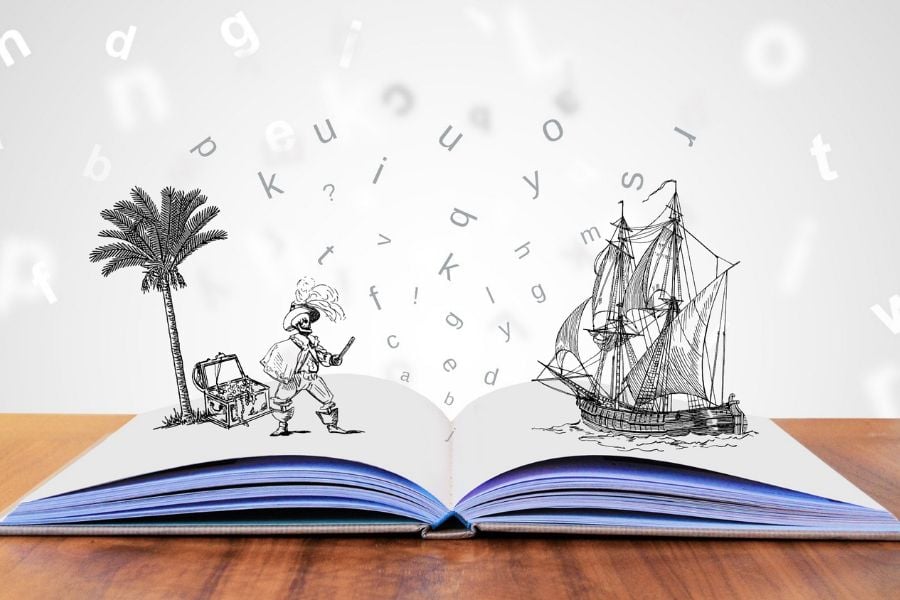Ever wondered how to self-publish a book in today’s ever-evolving digital world? Well, you’re not alone.
Every day, countless budding authors like you wonder how to turn their words into a tangible masterpiece.
Good news… in today’s digital age, it’s more achievable than ever.
And our guide is a roadmap that’ll unearth practical techniques and actionable strategies to bring your words to the world.
Ready?
Let’s jump in!

What is Self-Publishing?
Self-publishing is akin to being the captain of your ship. Instead of hitching a ride on a larger vessel (like a traditional publishing house), you’re at the helm, navigating through the waters of the publishing world on your terms.
Now, what distinguishes self-publishing from a traditional publisher?
When you opt for the traditional route, a publishing company evaluates your work, decides if it’s a good fit, and if they give the nod, they’ll handle all the heavy lifting — from cover design to marketing.
However, the catch is they take a considerable chunk of the profits.
On the other hand, with self-publishing, you’re in control from start to finish. It’s about freedom, creativity, and the unparalleled thrill of carving your unique path in the literary world.
So, as you ponder the road to take, remember that self-publishing isn’t just a path; it’s an adventure waiting to be embarked upon.
And for those willing to steer the ship, the horizon is vast and full of promise.
Why Consider Self-Publishing?
Let’s dive deeper and unearth some hidden treasures that self-publishing offers…
- Unbridled Creative Control: Remember that peculiar character or twist you thought might be too avant-garde for traditional publishers? With self-publishing, your story remains authentically yours. No need to trim your narrative wings; let your imagination soar.
- Direct Bridge to Readers: No middlemen, no waiting periods. You get to engage with your readers directly, making the feedback loop faster and more genuine.
- Flexibility in Pricing: Ever wanted to run a special book sale or offer a limited-time discount? Being at the helm means you dictate the pricing strategy, letting you be as dynamic and responsive as you wish.
- Higher Royalties: With fewer hands in the pie, your slice is more substantial. Platforms like Amazon Kindle Direct Publishing can net you up to 70% in royalties. Compare that to the typical cut from traditional avenues, and the numbers speak for themselves.
- Pioneering Your Niche: Got a story that doesn’t quite fit the mainstream mold? Perhaps it’s a hybrid genre or a topic that’s avant-garde. With self-publishing, niche works find their rightful place, and you could very well be the trailblazer for an entirely new genre or theme.
The world of self-publishing is alluring, but navigating it can be troublesome for beginners. Luckily we have a handy step-by-step guide…
8 Crucial Steps to Self-Publishing Your Book

Navigating the world of self-publishing might seem daunting at first, but when broken down into manageable steps, it becomes a thrilling journey of creativity and self-expression.
Let’s embark on this step-by-step guide to bringing your book to life…
Step 1: Picking the Right Platform
The first crucial decision authors face is choosing their self publishing platform. This step can make a significant difference in how your work is received and how much you earn from it.
Here are 3 leading platforms to consider…
Amazon Kindle Direct Publishing (KDP)
A giant in the realm of digital publishing, Amazon’s Kindle Direct Publishing (KDP) is the go-to platform for many first-time and independent authors.
Its vast global reach ensures that your book lands in the hands of readers from every corner of the globe.
Moreover, the streamlined publishing process means that your book can be live in a matter of hours after you hit ‘publish.’
While the global audience is tantalizing, remember that KDP operates in a saturated market. To stand out, you’ll need a blend of an engaging cover, a compelling blurb, and a dedicated marketing strategy.
And for those worried about exclusivity, fret not.
KDP doesn’t chain you to their platform, granting you the freedom to publish elsewhere.
Barnes & Noble Press
Barnes & Noble Press offers an elegant blend of tradition and modernity.
Rooted in the legacy of a renowned bookstore chain, this platform presents an opportunity for authors to see their work both online and potentially on physical bookshelves. It’s a nostalgic nod to traditional publishing, with the independence of the self-publishing model.
In addition to eBooks, B&N Press offers print-on-demand services, allowing your readers to hold a tangible manifestation of your creativity.
While they might not boast the global reach of Amazon, their brand name offers a stamp of credibility many new authors crave.
Apple Books
Dipping your toes into the realm of Apple Books means you’re reaching out to a dedicated, tech-savvy audience that values design and user experience.
The aesthetic appeal and fluidity of Apple products are known for spillover to their digital bookstore. This is a haven for authors who believe their books offer a visual and textual treat.
However, Apple Books does cater predominantly to the iOS ecosystem.
This might limit the reach but ensures a higher standard of presentation and layout for your work, especially if it contains interactive elements or multimedia.
Step 2: Choose Your Title

The title is more than just a cluster of words strung together; it’s the window to your story’s soul.
So, how can you captivate your audience’s attention and evoke curiosity, intrigue, and a certain mood via a title…
Harness Tools to Aid Inspiration
Finding the right words can sometimes be challenging, but you’re not alone in this journey.
Numerous online book title generator tools are available, designed specifically to jumpstart your creativity. Simply inputting keywords or significant themes from your book can generate a list of potential titles.
And while these generated titles can be a goldmine of inspiration, they’re most beneficial when used as springboards.
Let these suggestions spark your creativity, and then shape and refine them to align perfectly with your story’s essence.
Gathering Feedback Can Be Invaluable
Trusted friends, family, and especially those beta readers who’ve taken the time to delve into your manuscript can provide an outsider’s perspective on title contenders.
They come without the same intimate attachment to the work, allowing them to offer an unbiased view of how effectively a title captures interest and represents the book’s core themes.
Harnessing the Power of Brainstorming
Brainstorming isn’t just about putting down every title idea that comes to mind; it’s a creative exploration.
Dive back into your narrative. Are there recurring themes or standout phrases that encapsulate the essence of your story? Perhaps a unique dialogue or a symbolic element that threads through your narrative.
By revisiting the core of your narrative, you might just stumble upon a title that’s been waiting there all along.
Step 3: Format Your Book for Today’s Audience

In this golden age of book consumption, readers are not limited to traditional print.
Understanding these diverse reading habits and catering to them can not only significantly widen your audience but also enhance the reading experience for your fans.
Print-on-Demand (POD)
Think of Print-on-Demand (POD) as a bespoke suit — made just for you, exactly when you want it, with no wastage.
Imagine a reader in a quaint town wanting your book. Services like IngramSpark or KDP Print ensure a copy is printed and shipped directly to them.
No more guesswork on how many copies to print, and no more unsold stacks in warehouses.
eBooks
The beauty of eBooks is their accessibility. Formatting your work for eReaders ensures your story is available for such impromptu reading moments.
Tools like Calibre can help you in this endeavor.
And if you’re feeling overwhelmed by the tech side of things, platforms like Reedsy are brimming with professionals ready to lend a hand.
Audiobooks
Audiobooks have emerged as the dark horse of the publishing world. With their rising popularity, it’s no surprise that they’ve become a favorite for many.
It offers an added layer of creativity. The tone, pitch, and emotion of a voice artist can breathe life into your characters in ways print and digital can’t. Platforms like ACX (Audiobook Creation Exchange) serve as bridges, connecting authors with voice artists who can translate written words into vivid oral tales.
When choosing a voice artist, think of them as the narrator of your tale; their voice should resonate with the ambiance of your story.
Step 4: Create an Eye-Catching Book Cover

An engaging cover is undeniably crucial. It provides a window into the world you’ve crafted within the pages.
Let’s delve deeper into crafting a cover that not only stands out but also resonates with your intended readership…
Imagery
When readers stroll through the virtual aisles of an online bookstore or skim the shelves of their local library, the first thing that usually grabs their attention is the imagery on a book cover. This is your book’s first impression, and it needs to be a compelling one.
Always ensure that the primary image or design element encapsulates the essence of your story.
Reflect on iconic covers like “The Great Gatsby” with its discerning eyes and the luminous city below. It wasn’t just an arbitrary design; it captured the novel’s mood, setting, and mystery.
Typography
While imagery draws readers in, typography ensures they stay and take a closer look. Your font choice should complement the cover’s imagery and subtly convey the book’s tone.
Consider the book “Jurassic Park” by Michael Crichton. Its simple, bold font gives a sense of foreboding, hinting at the colossal prehistoric creatures that lie within.
Your typography shouldn’t be an afterthought; it’s an integral part of your cover’s narrative.
Color Psychology
Colors have a profound psychological impact on us. When chosen thoughtfully, they can amplify the emotions and themes of your book.
If you’re writing a gritty crime novel, darker hues like blacks, grays, and deep reds can instantly set the tone.
On the other hand, a memoir on personal growth and self-discovery might be best represented by soft pastels or earthy tones that evoke feelings of renewal and hope.
Step 5: The Magic Number — ISBN

At first glance, the International Standard Book Number (ISBN) might seem like a mere sequence of digits, a trivial barcode. But in the literary realm, it’s akin to a golden key…
Why It’s Important?
Every bookstore, from that cozy independent outlet on the corner to the massive online behemoths, relies on the ISBN. It’s the DNA fingerprint of your book.
Libraries, distributors, and retailers all over the world use it as a standard reference.
When a reader is enraptured by your story and wishes to recommend it to a friend or buy it as a gift, the ISBN ensures there’s no confusion about which edition or version they’re referring to.
But remember, each variation of your book (print, eBook, audiobook, etc.) will need its own ISBN
Purchasing Options
Navigating the ISBN purchase can seem like stepping into uncharted waters. While some platforms, such as Amazon KDP, might extend the offer of a free ISBN, it may come with limitations.
In the United States, Bowker is the official agency that provides ISBNs.
By buying directly from them, you retain the title of ‘publisher of record,’ which can be invaluable for authors looking to establish their independent brand.
Step 6: Pricing It Right

Determining the right price for your book can feel daunting. Price it too high, and you might deter potential readers; too low, and you might undervalue your hard work.
So, let’s delve into the nuances…
Cost Analysis
First and foremost, understanding the intrinsic costs associated with your book is paramount.
For physical books, this isn’t just the obvious printing costs but also factors in elements like cover quality, paper type, and even the color depth of the images inside.
On the digital front, while you may not have tangible printing costs, expenses such as formatting, cover design, and any enhanced multimedia features should be tallied. It’s essential to remember that while your eBook might not occupy a physical shelf, the virtual real estate it occupies has its own value.
Competitive Research
While your book is unique, it exists within an ecosystem of countless stories.
And understanding where you stand amidst this vast ocean can be enlightening. By scouring digital platforms, you can gauge the prevailing price ranges for titles similar to yours.
But here’s a golden nugget… don’t just look at the price; look at the value. Dive deep into reader reviews.
Books priced higher but with rave reviews clearly offer something exceptional, perhaps in content, presentation, or both. This can give you a hint about where your book might stand regarding perceived value.
Price Flexibility
The beauty of self-publishing lies in its dynamism. Unlike traditional publishing, where prices might remain stagnant for prolonged periods, you have the agility to adapt.
Consider running promotional discounts during festive seasons or special milestones. Perhaps your book is set during the summer. A summer book sale might just be the nudge a potential reader needs to dive into your world.
Furthermore, platforms like BookBub or even Amazon’s promotional tools allow you to reach a wider audience when you do offer these discounts.
And here’s the fascinating part… a temporary price drop can often lead to an influx of readers and, subsequently, reviews.
These reviews can, in turn, boost the book’s visibility and perceived value, making it more enticing even when it returns to its original price.
Step 7: Spreading the Word

Once your magnum opus is ready to see the light of day, it’s time to play the role of a marketer. After all, even the most captivating tales must find their way into readers’ hands…
Engaging Social Media Posts
In the age of the digital renaissance, social media platforms have emerged as powerful tools to connect with readers.
You could use Instagram’s visual allure to share evocative snippets of your book’s cover or pivotal scenes. Or perhaps you could harness Twitter’s brevity to quote thought-provoking lines from your narrative, sparking curiosity and conversation.
Moreover, platforms like Facebook offer community groups where passionate readers gather, hungry for their next favorite read.
By joining such communities, you’re not just promoting your work; you’re immersing yourself in a vibrant ecosystem of book lovers. A well-crafted post or discussion can have ripple effects, turning casual browsers into ardent fans.
Author Website
Think of your website as your personal bookstore. It’s a sanctuary where readers can delve deep into your literary universe, engage with your narratives, and discover the depths of your imagination.
By maintaining an active blog, sharing behind-the-scenes content, or even offering a free chapter, you can entice visitors to stay longer and explore further.
An author’s website is also a brilliant avenue for building an email list.
These subscribers are your most devoted fans, eagerly waiting for updates, launches, or even some personal anecdotes.
Cultivating this direct line of communication can foster a deeper bond with your readership and create anticipation for future works.
Strategic Collaborations
Networking can be a powerful catalyst in amplifying your book’s visibility. Consider collaborating with bloggers, fellow authors, or even podcasters in your genre.
Mutual interviews, guest blog posts, or joint promotional events can draw in a diverse audience, expanding your reach.
For instance, a fantasy author might partner with a popular podcast that dives into mythology and folklore. A joint episode dissecting the myths that inspired the book could intrigue listeners, guiding them to explore the novel itself.
Collaborations not only magnify your visibility but also enrich your understanding of the industry, its dynamics, and the ever-evolving tastes of readers.
Unlocking the Secrets of How to Self-Publish a Book

The idea of sending your literary baby out into the world can be overwhelming.
You’re probably thinking, “Can I really do this?”
Trust me, you can.
Your passion and determination, paired with the insights from this guide, will propel you forward.
Remember, every bestselling author started somewhere, just like you.
And the perks?
Creative control, potential royalties, and that unbeatable feeling of accomplishment.
You’ve got this! Now, go make your mark.



